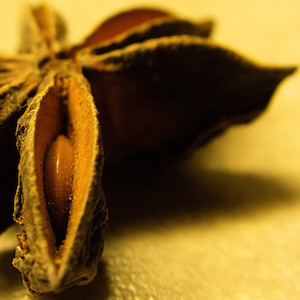Cooking Lessons

Three foreigners, teachers of English at the local university, all fair, blue-eyed, light-haired, walk to a small restaurant in a small corner of China called Anyang. The sun sinks behind a gauzy, polluted curtain. It’s dinner time and everyone is out: bicycles, cars, groups walking, stopping to browse, or eat in one of the matchbox-sized shops squeezed together along the spottily-lit, two-lane road. There’s no sidewalk. The city has more than two million people in the metropolitan area and was described to us as “small” by one of the Chinese teachers. This is no Shanghai with 23 million, but being almost the whole Western population in Anyang, we are beacons of foreignness. Kids, students, parents, grandparents, loudly whisper “lao wai” as we pass; some shout “Hello!” and giggle. I cling to the outside of the road, terrified of getting smashed by a speeding electric bike.
The facade of The Hotel Restaurant, like a lot of the buildings in China, is dirt-smeared white tiles. Food is a little more expensive here than at the tiny eateries we passed where our students eat, but we pay for atmosphere. The restaurant—we don’t know the actual name—is spacious: glass tabletops and hard mahogany chairs instead of plastic stools. There’s a bathroom, smelly, with squat toilets, but reasonably clean. The waitresses and waiters wear uniforms. They provide tea and sell bottled juice, milk, beer, and bai jiu—a clear, tasteless liquor that burns your tongue and throat like battery acid.
Robert, the New Zealander; Chris, my fellow American and boyfriend; and I push aside the laminated Chinese menu and pore over our cheat sheet, oil-stained and frayed at the edges. One column of characters, one of pinyin, the third a rough translation. Some of the translations, like “over the bridge noodles,” tell us little to nothing about what’s in the dish. The waitress brings a tea pot and hovers at the table speaking Mandarin at us.
“That’s nice,” Robert says, jabbing at xi hong shi ji dan (literally: tomato egg). “Zhi ge,” he says to the waitress.
“Zhi ge ma?” she says and scribbles on her note pad while we confer behind our cheat sheet. Robert rattles off suggestions. He’s lived in Anyang for five years and is in love with the food. But he’s amassed a vocabulary of about five words and so often gets by at restaurants by randomly pointing at something on the menu, which is trickier for Chris and me since we’re vegetarians. But we, clueless in this our first week living in China, are desperate. There’s no food at home but a couple persimmons we’re too nervous to eat yet because of all the warnings we heard about raw fruits and vegetables. We’re also miles and miles away from the nearest Western-style restaurant, not counting the local KFC. We gratefully let Robert order two dishes: spicy vermicelli noodles with peppers, and potatoes cooked in the salty, yet slightly sweet orange sauce he loves. Later, he’ll get us to try spicy tofu, stir-fried mushrooms, fried eggplant, egg and chives.
“And rice. Does everyone want rice? Mi fan,” he holds up three fingers. “San.”
The waitress asks us something we don’t understand so we offer tepid nods; she leaves and resumes her position around the perimeter of the restaurant with the other waitresses. They demurely fold their hands and wait until one of the customers barks, “fu wu yuan!” to demand tea or napkins or the bill. We three foreigners are reluctant to bark at waitresses, feeling it’s too impolite even as everyone else around us does it. We need more hot water for tea, and napkins, too, but we can only manage a loudly whispered, “foo yoo on.” Robert takes the white tea pot with the cracked spout and marches to the hot water dispenser by the exit. Finally, they spy this tall, strawberry blond lao wai, snatch the teapot and shoo him back to the table. On the way, he grabs napkins from a stack on the counter.
The food arrives piping hot, each dish gooped up on a big plate we’ll share. Three little bowls with perfect domes of rice follow. Garlic and vinegar and bizarre, slightly sour smells waft around the table.
Tomatoes and eggs: squishy, cooked tomatoes, their skins shriveled like wet paper, mixed with rubbery eggs. It reeks of texture violations. I pluck a bite-sized chunk of egg with my chopsticks. My lips pucker. Robert is already inhaling his food. I pop the bite into my mouth. The egg is chewy, the tomatoes soft, but they don’t remind me as much of baby food as I thought they would. Garlic and spices I don’t understand melt in my mouth in a way that can only be satisfied by eating more and more. I gobble it up.
*
The Hotel Restaurant, with its bizarre combinations—tomato and egg, a whole dish of nothing but tofu seasoned with chili peppers—is where I feel myself falling in love with Chinese cooking. It’s nothing like the all-you-can-eat buffets and cheap takeout with lots of heavy brown sauces and overcooked vegetables I experienced back home. There, I would always opt for pizza and Italian over “Chinese.” But the food in Anyang, at the outdoor vendors I buy lunch from, at the tiny eateries around the campus, baffles me, even something as simple as “garlic broccoli.” I poke the bright green trees with my chopsticks, study the pale, watery sauce and wonder how a vegetable I hated just weeks ago is now something I order almost every chance I get.
One month into our one-year contract and Chris and I can’t stand the food we make at home anymore. Blue packets of seafood-flavored ramen noodles. Imported Jif peanut butter smeared on flimsy, sugary bread. We use the wok to fry frozen spring rolls and red bean buns. Over and over we eat these prepackaged foods until I finally resolve to learn to cook. It’s the only way I’m going to survive China.
*
Our Chinese-language tutor, Catherine, and her friend Lucy, come over to teach us to cook a few dishes after I complained during one lesson how clueless I was. They are two slight, giggly girls in their last year of college that Marvin Han, one of the school’s teachers, found for us. They volunteered to come by our apartment once a week for a couple hours to teach us pu tong hua. The lessons begin with Catherine asking us if we have any questions and when we inevitably run out, she points to objects in the apartment and scribbles the characters loop-de-loop over the page. They wind up looking like scattered confetti. When we’re butchering the pronunciation of a word, she makes us repeat it over and over until she and Lucy are in a giggle fit, with me left wondering if I’m saying it correctly or not.
It’s not the rigorous grammar class I want. I want—need—help stringing a coherent sentence together. I want to decode what the waitress at The Hotel Restaurant says. Catherine and Lucy seem more interested in asking us questions about America.
They arrive on Sunday afternoon with their arms full of plastic bags brimming with noodles, tofu, eggs, and plenty of vegetables they just bought from the vendor down the road. His shop is like a mildewed basement, or the narrow hallway to a mildewed basement. Vegetables just ripped from the earth clutter the rickety tables: carrots and potatoes in need of several scrubbings, broccoli with their leaves attached, more varieties of leafy greens than I knew existed, leeks and green onions with pustules of dirt tangled in their roots. In summer, thin, prickly cucumbers and fat, juicy tomatoes spill outside and under the tables in cardboard boxes; in winter, huge tulip-like cabbages are stacked on blankets. In not quite two years, I’ll be back in Minnesota, walking through the fluorescent-lit produce section of a grocery store, where lettuce will have been washed and bagged, even the potatoes scrubbed. That’s when I’ll understand why I bought frozen, packaged foods those first weeks in Anyang.
I lead Catherine and Lucy to the small, drafty kitchen, fighting off embarrassment at the look of the rusted countertops that we hide with two big wooden cutting boards and a behemoth microwave. The cooking range sits on a portable counter unit in a nook that’s splattered with grease from the previous tenants. An apology for the constrained cooking conditions dances on my tongue: this is what it looked like when we moved in. The university provided what I hope are all the proper cooking utensils—a wok, a frying pan, a wooden spatula, chopsticks, and an assortment of big metal spoons I never use. There is no oven, which is part of my problem—all the lasagnas, frozen pizzas, and baked fish fillets haven’t prepared me for a two-burner cooking range.
I’m nervous that I’ll cut myself chopping, but Catherine only allows me to help her wash dirt from the chives, thin green shoelaces that wind around my wet fingers. My task complete, she shoos me out of the kitchen and goes to work.
“What is she doing in there?” I ask, hearing the cleaver hit the cutting board, the sizzle of hot oil. Chris shrugs and Lucy doesn’t acknowledge me. She’s quiet during our lessons except to help Catherine out with a translation.
Catherine signals me back to the kitchen. In the wok, oil and water bubble around thick slices of carrots and ginger. They’re so innocuous, just slices of carrots. She holds up a hunk of ginger that looks like a dry tree root, citrus-yellow inside.
“Put a little in there,” she says and hands me something else. It’s as hard as wood, blood-red, star-shaped. “And this. Don’t eat,” she warns. I’ll learn later it’s star anise, but I don’t even know where to buy it yet. I did know about carrots and cooking with ginger looks easy enough. She sprinkles a little salt in the wok and points to a bowl of already cooked, translucent potato noodles which she instructs me to “just cook.” It’s like I’m in a typical Chinese classroom: listen, but don’t participate. I convince myself I can handle this anyway since I cooked noodles all the time at home.
I’m ordered back to the table. Lucy springs up to retrieve the food: fingernail-thin slices of potatoes with vinegar and peppers, tofu with garlic and leafy greens, potato noodles with carrots and ginger.
As I try to shovel food in my mouth with chopsticks, often having to pick up a piece two or three times, I wonder how something as boring as lettuce can be made to taste like something you want to eat. And yet, when I try to imitate Catherine’s simple dishes, I panic at the stove. How much oil am I supposed to use? How long do the greens need to cook, how much ginger or garlic should I add? How do I make the noodles not clump together, the carrots not soggy, the watercress not overly limp and oily, the mushrooms tasting not like meat-fungus? I recall those tantalizing images of Catherine’s food made in my own kitchen and see what I have: chewy noodles and soggy carrots.
*
I admit that I know nothing about cooking carrots and though I made noodles—pasta—all the time back home, noodles in China flummox me. They can be made from rice and beans as well as potatoes and wheat, and I have no idea what you’re supposed to use what noodle for. Can you use rice noodles instead of potato noodles for carrots and noodles? It’s too much to take on at once so I retreat to xi hong shi ji dan. Tomatoes and eggs. So simple. Our favorite is from the The Muslim Restaurant around the corner from our apartment—they serve theirs mixed with noodles instead of with a side of rice. Chris and I have been eating it everywhere, our default dish, our comfort food. We’re becoming connoisseurs; we often order it when we travel around China, asking for it without our cheat sheet.
“You mei you xi hong shi ji dan?”
The waitress smiles at the foreigners who can speak a little pu tong hua. “You!” We have!
Every restaurant has tomatoes and eggs, but every one prepares it differently. I poke and prod and try to puzzle it out: a restaurant in Dengfeng adds green onions; another in Beijing cooks a gooier kind of sauce where tomato and egg meld into one, like Derby pie filling.
At home, I buy green onions, wash thoroughly the flecks of dirt in between the green skins. Chop lots of garlic. Try cooking the tomato and egg together, then separately. Fry an egg and add uncooked tomatoes that warm when mixed with the egg. Try tiny cherry tomatoes, big pink tomatoes. Try noodles again. Try rice! I ask for help. Catherine insists I boil water in the wok for the noodles while the tomato and egg cook in it. One bite of this sour, murky soup and the whole thing gets trashed. Cheryl, Robert’s Chinese girlfriend, tells me “it is very easy” to cook. I just need to use this particular “famous” spice mix usually used for dumplings. What ends up on my plate is rust-colored, too salty, and tongue-prickling to finish. Students I ask look at me, puzzled, and say, “Just cook it.”
But the recipe, I want to ask, what about the recipe? I’m convinced no one uses recipes, you either know how to cook xi hong shi ji dan or you don’t. I don’t. At the start of a semester, my new class always asks the same questions: can you use chopsticks, do you like Chinese food? I think they think I walk around with a fork in my pocket. (I actually bring a fork and knife to class once, and I watch 30, 40 pairs of hands mimicking as I say, knife in the right, hold fork in the left). And yes! Of course I like Chinese food. I ask the class what would I eat if I didn’t? Chris and I discover one restaurant besides KFC that cooks “Western” food—pizza with peas and not much sauce; dry, gray steak with a fried egg; and spaghetti. Only one supermarket sells foreign food, aside from the Snickers and Oreos you can find even at the dingy shops on campus. That market will get rid of its single row of imported pasta and sauces from Italy and granola from Germany and the racks of wine from California, France, and New Zealand, all before I leave. There will never be a bakery section with hearty breads and muffins, no dessert aisle with brownies and chocolate chip cookies, no cheese counter with my beloved Parmesan. I can’t “just cook” tomatoes and eggs any more than the Chinese chef can whip up a pizza.
*
Over a year passes since Catherine’s cooking lesson and I find myself in Anyang still, having signed on for one more year. My Mandarin and cooking skills have slightly improved, and I’m more confident ordering in restaurants and less embarrassed by the kitchen in the new apartment Chris and I moved into to escape the concrete floors and the drafty living room of our first. No rusted countertops, and we have cheery, turquoise kitchen cabinets.
Jenny, a friend and former student of Chris’s, will help us cook xi hong shi ji dan. She’s one of the brightest people I know. She actually bounces when she’s excited, which is often, and her English is superb. She bragged that she cooks delicious xi hong shi ji dan, but when she comes over, none of her shopping bags contain eggs and tomatoes. Instead, eggplant and tomato sauce, watercress, green onions, garlic, and pi zha, a local noodle-like specialty that’s gray and has the texture of jello.
I want to ask her where the tomatoes and eggs are since I thought Chris and I were clear that xi hong shi ji dan was the dish we wanted to learn to cook. Were we not clear enough? Did she think we meant eggplant and tomatoes? I’ll feel rude asking her since she bought all this other food and hauled it up five flights of stairs to teach us to cook. I must have missed something, some important cultural nuance. Did I? I keep silent.
With my notebook and pen, I hover over Jenny as she tosses ingredients at the cooking range. She doesn’t give me exact proportions so I count the number of garlic cloves, noting that she chops them into thick pieces and puts them into the hot oil first. She adds half a can of tomato sauce before the eggplant. She adds watercress, a smidgen of water (water! I never thought of that) and salt, and pushes it around the wok for a couple minutes, until it has shrunk to a crisp, summer green. She sprinkles the pi zha with cinnamon right before it comes off the burner.
We three feast on a meal that didn’t take half an hour to make, and I marvel at the speed and simplicity of the process, and how good everything turns out. Oil, garlic, salt, stir. It’s not complicated, but requires a certain way of thinking about cooking that I, with my baking and boil-water background, fail to understand. No wonder everyone has been telling me to “just cook.” They’ve grown up with this simple code in their bones. Would I have provided much better advice if a student asked me how to bake cookies, make spaghetti?
When I prepare dinner the next night, I take out the notebook, its pages already flecked with oil stains, and try to decipher my notes. I have tomatoes, green peppers, and garlic spread out on the counter, and think I can apply the principles of Jenny’s cooking to my new concoction, tomatoes and green peppers with rice. I’m afraid it’s as close to tomatoes and eggs as I’ll ever get. I pretend I’m creating a magical potion with a few ingredients, a dash of spice, a little soy sauce. Chop, chop, chop. The cleaver whacking the cutting board. Sizzle as the garlic hits the oil. A whoosh and steam poofs from the wok. The sizzle grows as I push the ingredients around with a wood spatula, my spoon in the cauldron.
The rice warms in the rice cooker. Once the tomatoes and peppers finish, I split them between two plates big enough to hold a side salad and divvy up the rice. Our Americanized Chinese dinner. Chris and I eat on the couch, plates balanced on our knees. We eat with forks since there are no Chinese to impress. We abandoned using chopsticks in private within the first month.
The taste, as my students would politely say, is “so so.”
Chris wolfs the food, pushing the final bits of rice onto his fork with his fingers and the plate is clean but for an oily residue.
“It was good, good,” he reassures, but he couldn’t possibly have tasted anything with how fast everything went down. Perhaps that’s the strategy. I eat too slow, my food half-finished. I shove it around my plate, wondering if there is enough garlic, enough salt. The green peppers are the color of pea soup; the tomatoes run all over the place. But, it’s not bad, it’s edible, my food has become edible. It’s an improvement from the time Catherine cooked in my kitchen. I try to look at this as a success, that I’m comfortable using a wok now, that Chris and I no longer need to buy frozen buns and ramen noodles, that I picked out the peppers myself from the vendor down the road. It is a success, but my cooking is painfully bland compared to the Chinese tastes: garlic that tickles your tongue, chilies that make your lips tingle, the savory sauces that let your whole mouth relish flavor.
*
Chris and I are sitting in our apartment, trying to decide what to do about dinner while listening to the growing cacophony of a whole city heading home for the night, stopping at the vegetable vendors to pick up food to cook, and going out to restaurants. It’s spring and in a couple months we’ll be on a plane back home, having had our fill of China in two years.
“Do you want to just go to The Muslim Restaurant?” Chris asks. It’ll be the third time in less than two weeks. If I say yes, he’ll scamper around the block to pick up xi hong shi ji dan, which he’ll bring back here, steaming in plastic bags. We avoid eating in the restaurant itself with the dirt-scuffed floor and smeared table tops that I never want to touch. But the food is always steaming. I consider The Hotel Restaurant, but we ate there with Robert last night and it seems pathetic to go two nights in a row.
I actually want to cook, but I consider the process involved in shopping for ingredients: fighting reckless cabs and bicycles and stares and “hellos.” I’ll have to wash and clean the vegetables back home and chop them and give them a little pep talk on how delicious they’re gonna taste (this time or else!). Sometimes it works. Sometimes it doesn’t. Today, the whole process fills me with a bone tiredness. Chris braves the journey to The Muslim Restaurant and I resolve to pick up vegetables on the way home from class tomorrow, though I’ll be relieved when I can boil water for spaghetti and just cook.










